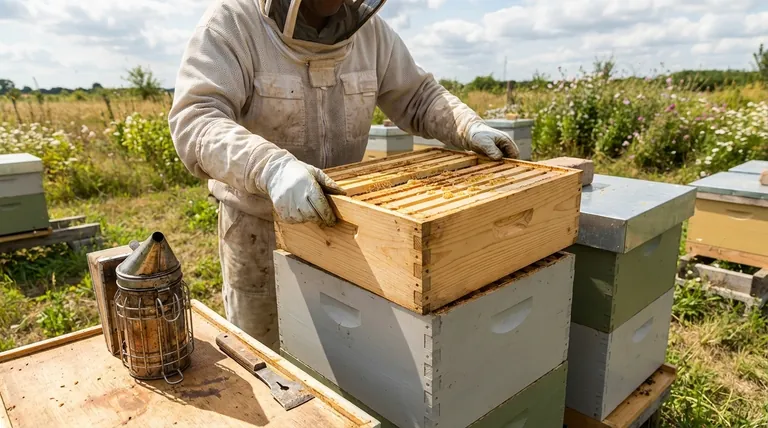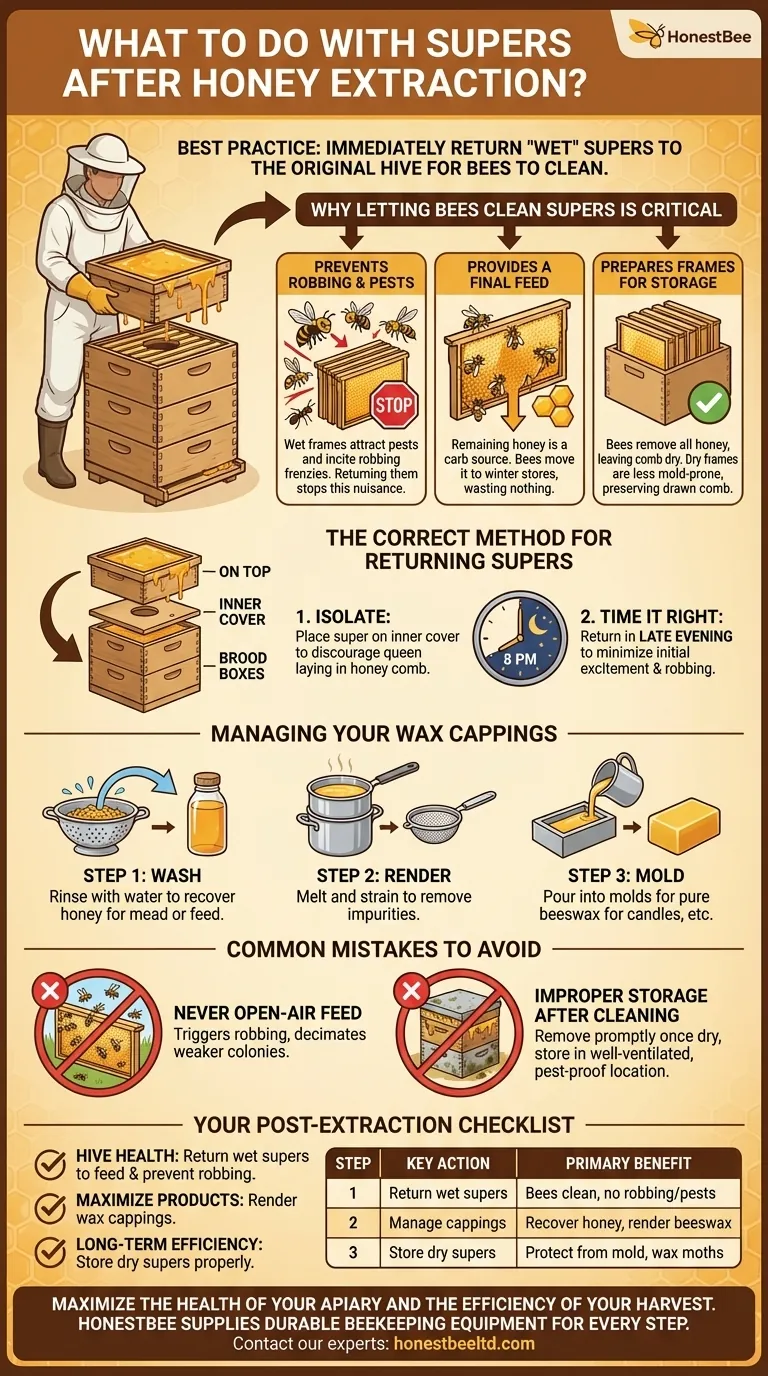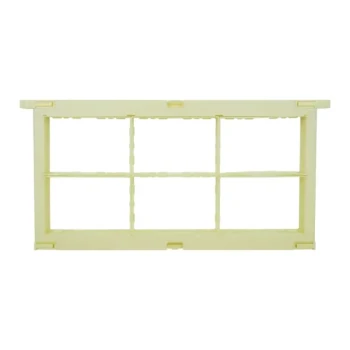Immediately after honey extraction, the best practice is to return the "wet" supers to the original hive for the bees to clean. This simple step prevents pests, provides the bees with valuable resources from the leftover honey, and perfectly prepares your equipment for long-term storage.
The goal after extraction is not just cleanup; it's a crucial final step in the honey harvest cycle that safeguards hive health, prevents pest infestations, and recycles valuable resources back into the colony.

Why Letting Bees Clean Supers is Critical
Returning wet supers to the hive is a standard practice for a reason. It leverages the bees' natural instincts to solve several post-extraction problems simultaneously.
Prevents Robbing and Pests
Wet frames left in the open are a powerful attractant. They can incite a "robbing frenzy," where bees from other colonies attack your hive to steal resources.
They also draw pests like wasps, ants, and hornets, creating a nuisance and a potential threat to your bees.
Provides a Final Feed for the Colony
The thin layer of honey remaining on the frames is a significant source of carbohydrates for your bees.
By cleaning the frames, they move this valuable resource down into their winter stores, ensuring nothing goes to waste.
Prepares Frames for Storage
Bees are incredibly efficient cleaners. They will remove every last drop of honey, leaving the comb perfectly dry.
Dry frames are far less likely to develop mold during storage, preserving your valuable drawn comb for the next season.
The Correct Method for Returning Supers
How you return the supers matters. A flawed method can create new problems, like encouraging the queen to lay eggs in your honey comb.
Isolate the Super
Place the wet super on top of the hive's inner cover, not directly on top of the brood boxes.
This separation discourages the queen from traveling up and laying in the honey combs, keeping them clean for future honey storage. The bees will travel up through the hole in the inner cover to access the frames.
Time it Right
Return the supers in the late evening.
This minimizes the initial excitement and reduces the chance of attracting bees from neighboring hives, which are less active at dusk. The bees will clean the frames over the next few days.
Managing Your Wax Cappings
The wax cappings sliced off during extraction are a valuable secondary harvest. Don't discard them.
Step 1: Wash to Recover Honey
The cappings are coated in honey. Place them in a colander or mesh bag and rinse them with water to dissolve the remaining honey.
This honey-water mixture can be used to make mead or, with caution, as a bee feed (it can ferment quickly).
Step 2: Render into Pure Beeswax
After washing, the cappings can be melted down. A simple double boiler or a dedicated solar wax melter works well.
Once melted, strain the liquid wax through several layers of cheesecloth to remove impurities (known as "slumgum").
Step 3: Mold and Use
Pour the clean, liquid wax into molds to create solid blocks of beeswax.
This pure beeswax can be used for countless projects, including making candles, lip balms, soaps, or furniture polish. It can also be traded for new hive foundation.
Common Mistakes to Avoid
A few common errors can turn this simple cleanup process into a major problem for your apiary.
Never Open-Air Feed
Do not leave wet supers or frames out in the open for bees to clean.
This is the fastest way to trigger a robbing frenzy, which can decimate weaker colonies in your area. Always return supers directly to their specific hive.
Improper Storage After Cleaning
Once the bees have cleaned the frames (they will be dry to the touch), remove them promptly.
Store the dry supers in a well-ventilated, pest-proof location. Stacking them and sealing the top and bottom can help prevent wax moth infestations.
Your Post-Extraction Checklist
Your approach should align with your beekeeping goals.
- If your primary focus is hive health: Always return wet supers to the hive for cleaning to provide a final feed and prevent robbing.
- If your primary focus is maximizing products: View wax cappings as a valuable second harvest and render them into clean beeswax for various uses.
- If your primary focus is long-term efficiency: Ensure your cleaned supers are stored properly to protect your equipment from mold and wax moths.
Properly managing your supers after extraction closes the loop on a successful harvest and sets your colonies up for a healthy future.
Summary Table:
| Step | Key Action | Primary Benefit |
|---|---|---|
| 1 | Return wet supers to the hive | Bees clean frames, preventing robbing and pests |
| 2 | Manage wax cappings | Recover honey and render valuable beeswax |
| 3 | Store dry supers correctly | Protect equipment from mold and wax moths |
Maximize the health of your apiary and the efficiency of your harvest.
Proper post-extraction management is crucial for commercial success. At HONESTBEE, we supply the durable, high-quality beekeeping supplies and equipment that commercial apiaries and distributors rely on for every step of the process, from harvest to storage.
Let us help you protect your investment. Contact our experts today to discuss your wholesale equipment needs and ensure your operation is built for longevity and productivity.
Visual Guide

Related Products
- Langstroth Honey Bee Box Hive Boxes for Different Depths
- Professional 500g Sectional Comb Honey Frame System for Beekeeping
- Australian Langstroth Beehive Boxes for Beekeeping Wholesales
- Twin Queen Styrofoam Honey Bee Nucs Mating and Breeding Box
- Portable Bee Mating Hive Boxes Mini Mating Nucs 8 Frames for Queen Rearing
People Also Ask
- Why do you need two bee hives? Boost Your Apiary's Success with Smart Risk Management
- What is the best time to inspect a hive? Optimize for Bee and Beekeeper Safety
- What are the sizes available for Langstroth boxes? A Guide to 8-Frame vs. 10-Frame & Depths
- What is the purpose of the boxes in a Langstroth hive? A Guide to Modular Beekeeping Success
- What are the sizes of supers available in a standard hive? A Guide to Deep, Medium, and Shallow Boxes



















